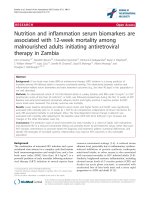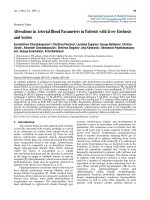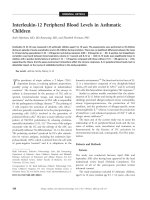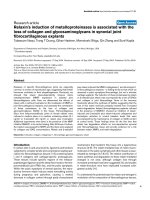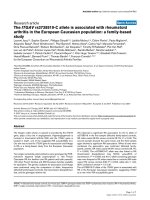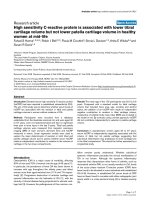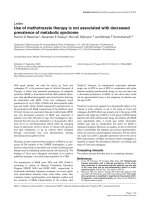Báo cáo y học: " Variations in arterial blood pressure are associated with parallel changes in FlowTrac/Vigileo®-derived cardiac output measurements: a prospective comparison study" potx
Bạn đang xem bản rút gọn của tài liệu. Xem và tải ngay bản đầy đủ của tài liệu tại đây (242.46 KB, 5 trang )
Open Access
Available online />Page 1 of 5
(page number not for citation purposes)
Vol 13 No 6
Research
Variations in arterial blood pressure are associated with parallel
changes in FlowTrac/Vigileo
®
-derived cardiac output
measurements: a prospective comparison study
Savvas Eleftheriadis
1
, Zisis Galatoudis
1
, Vasilios Didilis
2
, Ioannis Bougioukas
2
, Julika Schön
1
,
Hermann Heinze
1
, Klaus-Ulrich Berger
1
and Matthias Heringlake
1
1
Department of Anesthesiology, University General Hospital of Alexandropoulis, Dragana, Alexandropoulis, PC 68100, Greece
2
Department of Cardiothoracic Surgery, University General Hospital of Alexandropoulis, Dragana, Alexandropoulis, PC 68100, Greece
Corresponding author: Matthias Heringlake,
Received: 20 Jul 2009 Revisions requested: 15 Sep 2009 Revisions received: 21 Sep 2009 Accepted: 9 Nov 2009 Published: 9 Nov 2009
Critical Care 2009, 13:R179 (doi:10.1186/cc8161)
This article is online at: />© 2009 Eleftheriadis et al.; licensee BioMed Central Ltd.
This is an open access article distributed under the terms of the Creative Commons Attribution License ( />),
which permits unrestricted use, distribution, and reproduction in any medium, provided the original work is properly cited.
Abstract
Introduction The reliability of autocalibrated pressure waveform
analysis by the FloTrac-Vigileo
®
(FTV) system for the
determination of cardiac output in comparison with intermittent
pulmonary arterial thermodilution (IPATD) is controversial. The
present prospective comparison study was designed to
determine the effects of variations in arterial blood pressure on
the reliability of the FTV system in patients undergoing coronary
artery bypass grafting (CABG).
Methods Comparative measurements of cardiac output by FTV
(derived from a femoral arterial line; software version 1.14) and
IPATD were performed in 16 patients undergoing elective
CABG in the period before institution of cardiopulmonary
bypass. Measurements were performed after induction of
anesthesia, after sternotomy, and during five time points during
graft preparation. During graft preparation, arterial blood
pressure was increased stepwise in intervals of 10 to 15
minutes by infusion of noradrenaline and lowered thereafter to
baseline levels.
Results Mean arterial blood pressure was varied between 85
mmHg and 115 mmHg. IPATD cardiac output did not show
significant changes during periods with increased arterial
pressure either during sternotomy or after pharmacological
manipulation. In contrast, FTV cardiac output paralleled changes
in arterial blood pressure; i.e. increased significantly if blood
pressure was raised and decreased upon return to baseline
levels. Mean arterial blood pressure (MAP) and FTV cardiac
output were closely correlated (r = 0.63 (95% confidence
interval [CI]: 0.49 - 0.74), P < 0.0001) while no correlation
between MAP and IPATD cardiac output was observed. Bland-
Altman analyses for FTV versus IPATD cardiac output
measurements revealed a bias of 0.4 l/min (8.5%) and limits of
agreement from 2.1 to -1.3 l/min (42.2 to -25.3%).
Conclusions Acute variations in arterial blood pressure alter the
reliability of the FlowTrac/Vigileo
®
device with the second-
generation software. This finding may help to explain the variable
results of studies comparing the FTV system with other cardiac
output monitoring techniques, questions the usefulness of this
device for hemodynamic monitoring of patients undergoing
rapid changes in arterial blood pressure, and should be kept in
mind when using vasopressors during FTV-guided
hemodynamic optimization.
Introduction
Autocalibrated pressure waveform analysis by the FlowTrac/
Vigileo
®
(FTV) system allows determination of cardiac output
(CO) from the arterial pressure curve. Controversy exists
about the reliability of this technique in comparison with inter-
mittent pulmonary arterial thermodilution (IPATD), especially
during cardiac surgery [1,2]. A recent meta-analysis came to
the conclusion that "cardiac output values provided by the
FloTrac/Vigileo
®
operating systems with software version 1.07
or later show acceptable agreement with ITD (intermittent
CABG: coronary artery bypass grafting; CI: confidence interval; CO: cardiac output; FTV: FlowTrac-Vigileo
®
; GP: graft preparation; ICU: intensive
care unit; IPATD: intermittent pulmonary arterial thermodilution; MAP: mean arterial blood pressure.
Critical Care Vol 13 No 6 Eleftheriadis et al.
Page 2 of 5
(page number not for citation purposes)
thermodilution), both clinically and statistically" [3]. This con-
clusion contrasts sharply with our own results [4] and obser-
vations from Compton and colleagues [5] showing more than
40% percentage error in CO measurements by FTV in com-
parison with IPATD or transpulmonary thermodilution with the
PiCCO
®
-system.
When using the FTV-system in patients undergoing non-car-
diac surgery and critically ill patients in the intensive care unit
(ICU) we have frequently observed increases in CO following
a bolus of a vasopressor titrated to achieve a normal mean
arterial blood pressure (MAP). This is a unique finding and is
in contrast to what is to be expected from physiology, because
the normal CO response during an increase in afterload in a
patient with preserved cardiac function would be a short-last-
ing decrease in stroke volume followed by restoration of stroke
volume and CO to the previous level, but not an increase in
CO [6].
The present study was thus designed to determine the effects
of variations in arterial pressure on the reliability of CO meas-
urements by autocalibrated pulse wave analysis with the FTV
system in comparison with IPATD. With respect to the fact
that pulmonary artery catheters are routinely used in the car-
diac anesthesia department but not in the noncardiac surgery
population, the study was performed in cardiac surgery
patients undergoing coronary artery bypass grafting (CABG)
in the period before cardiopulmonary bypass.
Materials and methods
Following approval by the local ethical committee (Scientific
council of the General Hospital of Alexandropoulis) and writ-
ten informed consent, 16 consecutive patients (all male)
scheduled for standard on-pump CABG with moderate hypo-
thermia were enrolled (mean ± standard deviation: age: 62 ±
10 years, weight: 83 ± 11 kg; height: 167 ± 8 cm, left ven-
tricular ejection fraction: 64 ± 10%) for this prospective com-
parison study. All patients had a three-vessel coronary artery
disease, a history of arterial hypertension, and hyperlipidemia.
Three patients had diabetes and one had a history of stroke.
Following premedication with oral diazepam, general anesthe-
sia was induced with fentanyl and etomidate and maintained
with propofol and remifentanyl, as appropiate. Endotracheal
intubation was facilitated with cisatracurium. All patients were
equipped with a five lead electrocardiogram, a femoral arterial
line, a triple lumen central venous catheter and a pulmonary
artery catheter connected to a Vigilance I monitor (Edwards
Lifesciences, Irvine, CA, USA).
After induction of anesthesia the pulmonary artery catheter
was floated into the pulmonary artery until a typical pressure
profile was obtained. Thereafter, a FloTrac/Vigileo
®
system
(Edwards Lifesciences, Irvine, CA, USA) was connected to
the femoral arterial line, the transducer was adjusted to the
level of left atrium and the system was started according to the
instructions of the manufacturer (including entering the
requested demographical data of the patient).
In the further course, comparative measurements of CO by
IPATD and the FTV system were performed. MAP was
recorded concomitantly. Bolus thermodilution CO measure-
ments were performed in triplicate to quadruplicate with 4°C
cold saline and averaged for respective time points. In general,
three thermodilution measurements were performed. If the dif-
ference between these measurements was greater than 0.5 l/
min, an additional measurement was performed and the three
most contiguous results were averaged.
Autocalibrated CO measurements from the FTV system were
recorded immediately after a bolus of saline was given for ther-
modilution (resulting in three to four measurements each that
were again averaged). To assure adequate pressure record-
ings the arterial line was repeatedly flushed with 5 ml saline
throughout the observation period and observed for tracing
quality.
Comparative measurements were performed after induction,
after sternotomy, and in the period of graft preparation (GP1
to GP5) before cardiopulmonary bypass. During graft harvest-
ing, arterial blood pressure was titrated in periods of 10 to 15
minutes from a stable baseline around 80 mmHg (GP1 and
GP2) to 100 mmHg (GP3) and further to higher than 110
mmHg (GP4) by a continuous infusion of noradrenaline (2.6
μg/min to 6.6 μg/min). Thereafter blood pressure was allowed
to decrease back to levels around 80 mmHg (GP5).
Statistical analyses
Data analyses were performed by MedCalc 10.4 (MedCalc
Software bvba, Mariakerke, Belgium). Following Kol-
mogoronov-Smirnov test for normal distribution, data were
analyzed parametrically. Between group differences were ana-
lyzed by analysis of variance. Intraindividual changes were ana-
lyzed by paired Student's t-test with Bonferoni-adjustment.
Correlation analyses were performed by linear regression.
Comparisons between methods were performed by Bland-Alt-
man statistics. A P < 0.05 was considered statistically signifi-
cant.
Results
The course of CO measurements and MAP is given in Figure
1, showing significant increases in MAP after sternotomy and
during GP 3 and GP 4. No significant changes in IPATD
cardac output were observed while FTV CO significantly
increased during these blood pressure steps. Heart rate did
not change significantly throughout the study period (data not
shown).
Correlation analysis revealed moderate correlations between
FTV-CO and IPATD-CO (r = 0.51, 95% confidence interval
Available online />Page 3 of 5
(page number not for citation purposes)
(CI): 0.35 to 0.64, P < 0.0001) and between MAP and FTV-
CO (r = 0.63, 95% CI: 0.49 to 0.74, P < 0.0001) but no cor-
relation between MAP and IPATD-CO. Bland-Altman analyses
for FTV-CO versus IPATD-CO revealed a bias 0.4 l/min and
limits of agreement from 2.1 to -1.3 l/min for the pooled data
(Figure 2). The respective percentage results were: bias 8.5%,
limits of agreement 42.2% to - 25.3%.
Bland-Altman analyses at the individual data acquisition points
are shown in Table 1, showing percentage errors higher than
30% at most measurement points and an increase in bias at
the time points with raised MAP.
Discussion
Adequate monitoring of CO and stroke volume is a pivotal part
of any hemodynamic optimization protocol and has tradition-
ally been accomplished by using a pulmonary artery-catheter.
And although it is now clearly established that the use of a pul-
monary artery catheter is not associated with an increase in
mortality, its use should be restricted to units with specialized
knowledge and experience in using this technology [7]. Within
the past years several alternative devices for the monitoring of
CO have been developed and introduced into clinical practice.
One of the most recent developments is autocalibrated pres-
sure waveform analysis by the FTV system [8]. The system dif-
fers from conventional pulse contour analysis systems (which
are externally calibrated by bolus thermodilution) by using indi-
vidual demographics, the skewness, and the kurtosis of the
pulse to estimate arterial compliance and to adapt for changes
in vascular tone. Following initial disappointing results [9] the
software has undergone several refinements and the manufac-
turer now claims that it adapts every minute for changes in
arterial compliance.
It is well known that changes in arterial resistance either by a
vasodilating or a vasoconstricting agent may change pulse
wave velocity and thereby influence peripheral as well as cen-
tral aortic pulse contour [10]. In line with this, it has repeatedly
been shown that conventional calibrated pulse contour CO
monitors such as the PiCCO
®
need repeated recalibration if
such changes occur [11,12]. The present study was designed
to determine if the FTV-system is robust against changes in
vascular tone, that is an increase in vascular resistance
induced by infusion of a vasopressor.
Our results clearly show that the autocalibration algorithm of
the FTV system was not capable to adapt to changes in MAP
between 80 to 110 mmHg (that were maintained for 10 to 15
minutes) although the software generation used calculates
arterial compliance every minute: results in a percentage error
between both methods that is clinically not acceptable. This is
highly suggestive that the algorithm fails to detect short-term
changes in systemic vascular resistance and may help to
explain why the FTV-system has repeatedly been shown to
underestimate CO in the immediate period after cardiopulmo-
nary bypass or in patients with liver cirrhosis (i.e. during a
vasodilatatory state with decreased vascular resistance
[9,13]) but is capable of reliably detecting fluid induced
changes in stroke volume (i.e. changes in preload that are typ-
ically not accompanied by immediate changes in vascular
tone) [14] or pacing induced changes in CO [15]. Unfortu-
nately, we did not use any direct and objective measures to
determine vascular resistance (i.e. determination of forearm
Figure 1
Cardiac output and mean arterial pressure during the study periodCardiac output and mean arterial pressure during the study period. The
time course of (a) cardiac output (CO) determined by intermittent pul-
monary arterial thermodilution (filled circles = IPATD-CO) and autocali-
brated pressure waveform analysis with the FlowTrac/Vigileo
®
system
(filled squares = FTV-CO) and (b) mean arterial pressure (MAP) in
patients undergoing coronary artery bypass grafting surgery before car-
diopulmonary bypass subjected to variations in arterial blood pressure
either by the surgical stimulation or noradrenaline infusion. * significant
difference (P < 0.05) in comparison with the previous time point (Stu-
dent's t-test with Bonferoni-correction). § significant difference
between IPATD-CO and FRV-CO (analysis of variance) AI = after
induction; AS = after sternotomy; GP = graft preparation. CABG =; CI
= confidence interval; CO = cardiac output; FTV = Flowtrac-Vigileo
®
;
GP = graft preparation; IPATD = intermittent pulmonary arterial ther-
modilution; ICU = intensive care unit; MAP = mean arterial blood pres-
sure.
Critical Care Vol 13 No 6 Eleftheriadis et al.
Page 4 of 5
(page number not for citation purposes)
blood by strain gauge) and thus this explanation remains spec-
ulative.
It is of note, that the percentage error at most measurement
time points was higher than 30% and that the FTV system per
se did not reliably measure CO in comparison with IPATD,
even if arterial blood pressure was in the normal range. This
further questions the clinical usefulness of this device, at least
with the software version used in this study.
Conclusions
The results of the present study show that changes in sys-
temic arterial resistance alter the reliability of the FTV-system;
even if using the modified second-generation software (ver-
sion 1.14). This may help to explain the variable results of stud-
ies comparing the FTV-system with other CO monitoring
techniques, questions the usefulness of this device for hemo-
dynamic monitoring of patients undergoing rapid changes in
arterial blood pressure, and should be kept in mind when using
Figure 2
Bland-Altmann plot of absolute cardiac output data determined by intermittent pulmonary arterial thermodilution (IPATD-CO) and autocalibrated pressure waveform analysis with the Flowtrac/Vigileo
®
-system (FTV-CO) throughout the studyBland-Altmann plot of absolute cardiac output data determined by intermittent pulmonary arterial thermodilution (IPATD-CO) and autocalibrated
pressure waveform analysis with the Flowtrac/Vigileo
®
-system (FTV-CO) throughout the study. Closed circles = after induction; open circles = after
sternotomy; closed squares = graft preparation 1; open squares = graft preparation 2; open stars = graft preparation 3; closed stars = graft prepa-
ration 4; closed triangles = graft preparation 5.
Table 1
Results of the Bland-Altman analyses at different time points
AI AS GP1 GP2 GP3 GP4 GP5
Raw data
Upper LoA (l/min) 1.46 2.2 1.27 1.28 1.74 2.63 1.6
Bias (l/min) 0.18 0.6 -0.02 0.07 0.74 1.73 -0.1
Lower LoA (l/min) -1.11 -1.0 -1.32 -1.15 -0.21 0.83 -1.7
Percentage data
Upper LoA (%) 36.1 44.6 28.8 31.5 34.0 48.0 38.3
Bias (%) 5 12.2 0.3 2.2 15.4 30.8 0.5
Lower LoA (%) -26.1 -20.2 28.3 26.9 -3.2 13.5 -37.3
AI = after induction; AS = after sternotomy; GP 1 to 5 = graft preparation time points 1 to 5; LoA = limits of agreement (1.96 standard deviations).
Available online />Page 5 of 5
(page number not for citation purposes)
vasopressors during FTV-guided hemodynamic optimization.
Further studies are needed to reveal if the most recent modifi-
cation of the FTV-system software (the third generation)
improves the reliability of this technology.
Competing interests
The authors SE, ZG, VD, IB, JS, HH, and KUB declare that
they have no competing interests. MH received scientific sup-
port and/or honoraria for lectures from Edwards Lifesciences,
Irvine, CA, USA, the manufacturer of the FloTrac/Vigileo
®
-
system, Osypka Medical, Germany, and Covidien, Germany.
Authors' contributions
SE, JS, and MH designed the study, performed the statistical
analyses and drafted the manuscript. SE, ZG, VD, and IB coor-
dinated the study, were responsible for patient recruitment
and data acquisition. HH and KUB were involved in the inter-
pretation of the data and manuscript drafting. All authors read
and approved the final manuscript.
Acknowledgements
We deeply acknowledge the continuous support of our institutional stat-
istician Michael Hüppe, PhD.
References
1. Zimmermann A, Kufner C, Hofbauer S, Steinwendner J, Hitzl W,
Fritsch G, Schistek R, Kirnbauer M, Pauser G: The accuracy of
the Vigileo/FloTrac continuous cardiac output monitor. J Car-
diothorac Vasc Anesth 2008, 22:388-393.
2. Sander M, Spies CD, Foer A, von Heymann C: Cardiac output
measurement by arterial waveform analysis in cardiac sur-
gery a comparison of measurements derived from wave-
forms of the radial artery versus the ascending aorta. J Int Med
Res 2008, 36:414-419.
3. Mayer J, Boldt J, Poland R, Peterson A, Manecke GR Jr: Continu-
ous arterial pressure waveform-based cardiac output using
the FloTrac/Vigileo: a review and meta-analysis. J Cardiotho-
rac Vasc Anesth 2009, 23:401-406.
4. Eleftheriadis S, Heringlake M, Berger K-U, Groesdonk HV, Schön
J: Lack of reliability of cardiac output measurements derived
from arterial pressure waveform analysis in on-pump cardiac
surgery patients. In IFMBE Proceedings 25/VII Berlin, Heidel-
berg, NewYork: Springer; 2009:559-562.
5. Compton FD, Zukunft B, Hoffmann C, Zidek W, Schaefer JH: Per-
formance of a minimally invasive uncalibrated cardiac output
monitoring system (FloTrac/Vigileo) in haemodynamically
unstable patients. Br J Anaesth 2008, 100:451-456.
6. West J: The cardiac pump. In Best and Taylor's Physiological
Basis of Medical Practice 12th edition. Baltimore: Williams &
Wilkins; 1989:234-235.
7. Vincent JL, Pinsky MR, Sprung CL, Levy M, Marini JJ, Payen D,
Rhodes A, Takala J: The pulmonary artery catheter: in medio vir-
tus. Crit Care Med 2008, 36:3093-3096.
8. Manecke GR: Edwards FloTrac sensor and Vigileo monitor:
easy, accurate, reliable cardiac output assessment using the
arterial pulse wave. Expert Rev Med Devices 2005, 2:523-527.
9. Sander M, Spies CD, Grubitzsch H, Foer A, Muller M, von Hey-
mann C: Comparison of uncalibrated arterial waveform analy-
sis in cardiac surgery patients with thermodilution cardiac
output measurements. Crit Care 2006, 10:R164.
10. O'Rourke MF, Pauca A, Jiang XJ: Pulse wave analysis. Br J Clin
Pharmacol
2001, 51:507-522.
11. Bein B, Meybohm P, Cavus E, Renner J, Tonner PH, Steinfath M,
Scholz J, Doerges V: The reliability of pulse contour-derived
cardiac output during hemorrhage and after vasopressor
administration. Anesth Analg 2007, 105:107-113.
12. Sander M, von Heymann C, Foer A, von Dossow V, Grosse J,
Dushe S, Konertz WF, Spies CD: Pulse contour analysis after
normothermic cardiopulmonary bypass in cardiac surgery
patients. Crit Care 2005, 9:R729-734.
13. Della Rocca G, Costa MG, Chiarandini P, Bertossi G, Lugano M,
Pompei L, Coccia C, Sainz-Barriga M, Pietropaoli P: Arterial pulse
cardiac output agreement with thermodilution in patients in
hyperdynamic conditions. J Cardiothorac Vasc Anesth 2008,
22:681-687.
14. Senn A, Button D, Zollinger A, Hofer CK: Assessment of cardiac
output changes using a modified FloTrac/Vigileo algorithm in
cardiac surgery patients. Crit Care 2009, 13:R32.
15. Ostergaard M, Nielsen J, Nygaard E: Pulse contour cardiac out-
put: an evaluation of the FloTrac method. Eur J Anaesthesiol
2009, 26:484-489.
Key messages
• Variations in arterial blood pressure lead to parallel
changes in CO measurements by the second genera-
tion of the FTV system.
• This questions the usefulness of this device for hemody-
namic monitoring of patients undergoing rapid changes
in arterial blood pressure and should be kept in mind
when using vasopressors during Flowtrac/Vigileo
®
-
guided hemodynamic optimization.

